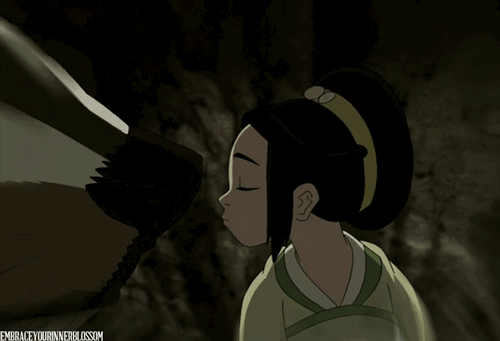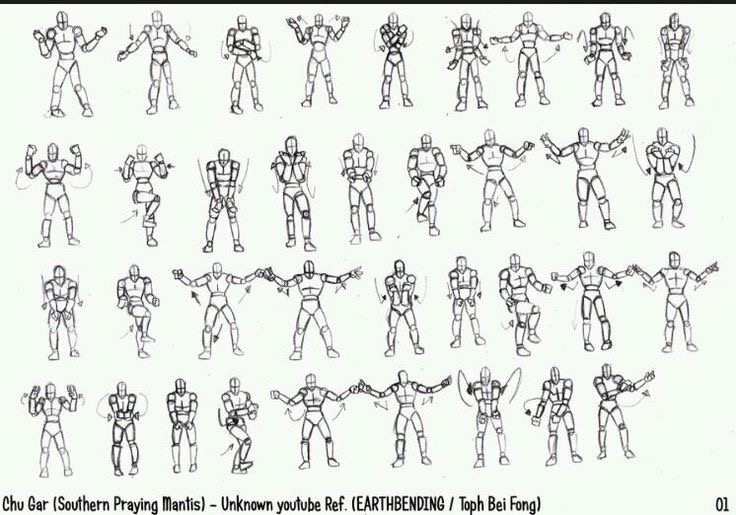Avatar Martial Arts Southern Shaolin Martial Art Fighting Positions Avatar
Avatar: The Final Airbender features i of the almost visually fascinating magic systems. In the show, i's unique "qi" or energy enables them through grounded movements and stances to manipulate water, earth, burn, or air. When creators Bryan Konietzko and Michael Dante DiMartino first came up with this idea, they knew bending should not just be a magical concept. Rather, the angle movements needed "to be grounded in reality" (pg. 26,Avatar: The Last Airbender, The Art of the Animated Serial)

To accomplish this, Bryan decided to start preparation in kung fu, specifically, the Northern Shaolin style. Somewhen, he took classes from Sifu Kisu, who and then suggested, clearly excited, "assigning a specific bailiwick of Chinese martial arts to each nation and element based on each fashion'south characteristics." (Pg. 26,The Art of the Animated Series). Sifu Kisu later on became the fighting instructor and consultant for the show because of his cognition of a wide range of martial art styles.
Thus, bending became something more than simply a fancy magical illusion. Each type of bending is different but notwithstanding continued to the others as a concept of strength and focus. Below, I listed the four main stylesAvatarused, as well as Toph's unique bending style.

Waterbending- T'ai Chi
Known also by its formal proper noun T'ai chi ch'uan (which translates to "supreme ultimate fist" in Chinese), information technology is a Chinese martial art ancient practitioners founded around the 12th century in Taoist and Buddhist monasteries. Its practices straight derive from these two philosophies representing the fusion or mother, otherwise known as "Yin and Yang."

Audio familiar? Fans would recognize this from the Season 1 finale "The Siege of the North: Parts 1 &two". Unlike the other elements, Waterbenders learned from the moon and ocean spirits, who had crossed into the mortal globe. As Koh the confront stealer surmised,
Tui and La, your moon and sea, accept always circled each other in an eternal trip the light fantastic toe. They balance each other. Push and Pull. Life and Death. Proficient and Evil. Yin and Yang.

Sifu Kisu explained that "T'ai Chi is less almost strength and more than about alignment, body structure, breath and visualization" (Behind the Scenes,Kung Fu Featurette, "Waterbending"). For training, practitioners employ 5 elements: taolu (solo hand and weapons routines and forms), neigong and qigong (breathing, movement and awareness exercises, and meditation), tuishou (response drills), and sanshou (self-defense techniques). (Douglas Wiles,Taijiquan and Taoism from Religion to Martial Art and Martial Art to Religion).

T'ai Chi was the ideal way for Waterbending because of its softness, which hides a deep, nigh indecipherable strength that is more effective than outright aggression.

Earthbending- Hung Gar
Otherwise known as Hung Gar Kuen, meaning "immense fist," Hung Gar is a southern Chinese martial art. Survivors of the destruction of the Shaolin Temple founded it during the 14th century Ming Dynasty. (the approximate engagement is never fully stated, so I gave information technology my best-educated gauge). Since it mirrors animal movements in its forms, many martial artists also refer to it as the "tiger and crane" style.

In the testify, the original Earthbenders were badger moles who passed their knowledge to humans. The evidence first notes this in "The Cave of 2 Lovers," where the founders of Omashu (two lovers Oma and Shu) learned from them and then they could make tunnels between their opposing clans. This is a fitting idea since Hung Gar follows the movements of animals closely.

Hung Gar, as Sifu Kisu explained information technology, involves low stances rooted to the ground and stiff steps. (Behind the Scenes:Kung Fu Featurette, "Earthbending"). Traditionally, since it has such deep positions, students trained for upwardly to three years to build the correct stamina and muscle force. These students normally stayed in si ping ma (horse stance) for 30 minutes to several hours a day. Each proceeding form takes upwardly to ane year to chief.

This solidity and firm connection to the earth makes it perfectly ideal for Earthbending.

Firebending- Northern Shaolin
Northern Shaolin, or Běishàolín, is the most prominently good Northern Chinese martial art. It originates from the Henan monastery roughly around the 7th or 8th century, during which time monks start adult spear and staff techniques. Eventually, during the 17th Ming-Qing dynasty, monks established themselves as experts in unarmed combat. Though known worldwide as only 1 mode, private temples developed their unique variation of the practice.

Originally, Firebenders learned from the dragons, but later on Firelord Sozin started the state of war, dragon hunting became more prominent. In "The Firebending Masters," Aang and Zuko detect the two remaining dragons who reveal the true nature of firebending. Rather than a class of devastation, at its root, it is energy and life. Near Firebenders allowed acrimony or muscles to define their angle, having deterred from the element'south source.

Being his way of preference, Sifu Kisu explained how Northern Shaolin uses "wide stances, quick advances and retreats, kicking and leaping techniques, whirling circular blocks, quickness, agility and aggressive attacks" (Behind the Scenes,Kung Fu Featurette, "Firebending"). In its curriculum, there are x standardized forms: Kaimen (Essential Entry or Basic Skills), Lǐnglù (Pb the Opponent to his defeat), Zuoma (Counter Attacks), Chuanxin (Attacks up the solar plexus), Wuyi (Gainsay Techniques), Duanda (Close see combinations), Meihua (Breaking an ambush), Babu (Open-space fighting combinations), Lianhuan (Chained multiple strikes) and Shifa (The essence of style). (pathsatlana.org).

With its focus on stiff, dynamic power centered on proper animate it is a martial artconforming the energy of Firebending.

Airbending- Ba Gua
Also referred to as Baguazhang, Ba Gua is a Wudang school mode meaning "eight trigram palm." Information technology derives from the trigrams in the I Ching canon in Taoism. Created by Dang Haichuan in the 19th century by rural Taoist and Buddhist masters, practitioners mainly view it as an internal exercise (neijia gong) focused on spiritual, mental, or qi-related refinement (life force, breath, or personal energy).

Airbenders originally learned bending from the flying bison and further developed defensive fighting techniques. As the element of freedom, mastering the unlike physical forms sets the foundation for further spiritual enlightenment. For combat, the key is finding the path of least resistance and adapting to dangerous situations through evasive maneuvering rather than directing facing the source.

Ba Gua practices center on circular walking and movements. Since Ba Gua practitioners constantly move, attackers accept difficulty making directly physical contact. This constant movement builds free energy and power that proves formidable for opponents if they are farther intimidated. (Backside the Scenes,Kung Fu Featurette, "Airbending"). As a role of the grooming, students primarily practice circle walking. To master this, students and practitioners walk in various depression stances, changing direction when needed. This preparation helps develop flexibility and correct body alignment, leading to more advanced kicks, throws, joint locks, and evasive circular footwork. (brisbanekungfu.com)

Equally a mode fixed on circular and evasive maneuvering, it is ideal for the pacified and spiritual nature of Airbending. (Note: This is the style I would exist most interested in learning.)

Toph- Chu Gar Southern Praying Mantis Style
The distinct fashion used by the Hakka people, Chu Gar is one of six Southern Praying Mantis, or nán pài tángláng, styles originating from the Chu family. Non related to the Northern Praying Mantis mode, its origin is difficult to trace, just historians and practitioners speculate it surfaced effectually the 19th or 20th century.

Toph developed her unique fighting style later on learning from badger miles outside her habitation. Beingness blind, she used Earthbending to extend her senses to help her come across and connect to her abilities. Ironically, there is one legend continued to her fighting style that tells of another blind woman founding this martial art. Since Earthbending began as a tool for seeing and interacting, her techniques adult around watching, waiting, and attacking at the advisable time.


Chu Gar and other Southern Praying Mantis practices emphasize shut gainsay and curt-power methods. Meaning, i does not give everything in one attack just uses a series of smaller attacks to weaken an opponent and then administrate the final accident. Different Hung Gar, it focuses more on mitt and arm techniques and limited depression kicks. Quite like "street fighting," information technology uses a diversity of upper trunk attacks to inflict injury while the lower torso remains steady, only periodically delivering low, quick kicks for balance.

For Toph'southward more rugged and wistful fashion, Southern Praying Mantis seemed the ideal choice peculiarly since she afterwards used it to discover Metalbending.
Thank you for reading!
Source: https://aebperspective.com/2015/09/18/the-fighting-styles-of-avatar-the-last-airbender/
0 Response to "Avatar Martial Arts Southern Shaolin Martial Art Fighting Positions Avatar"
Post a Comment